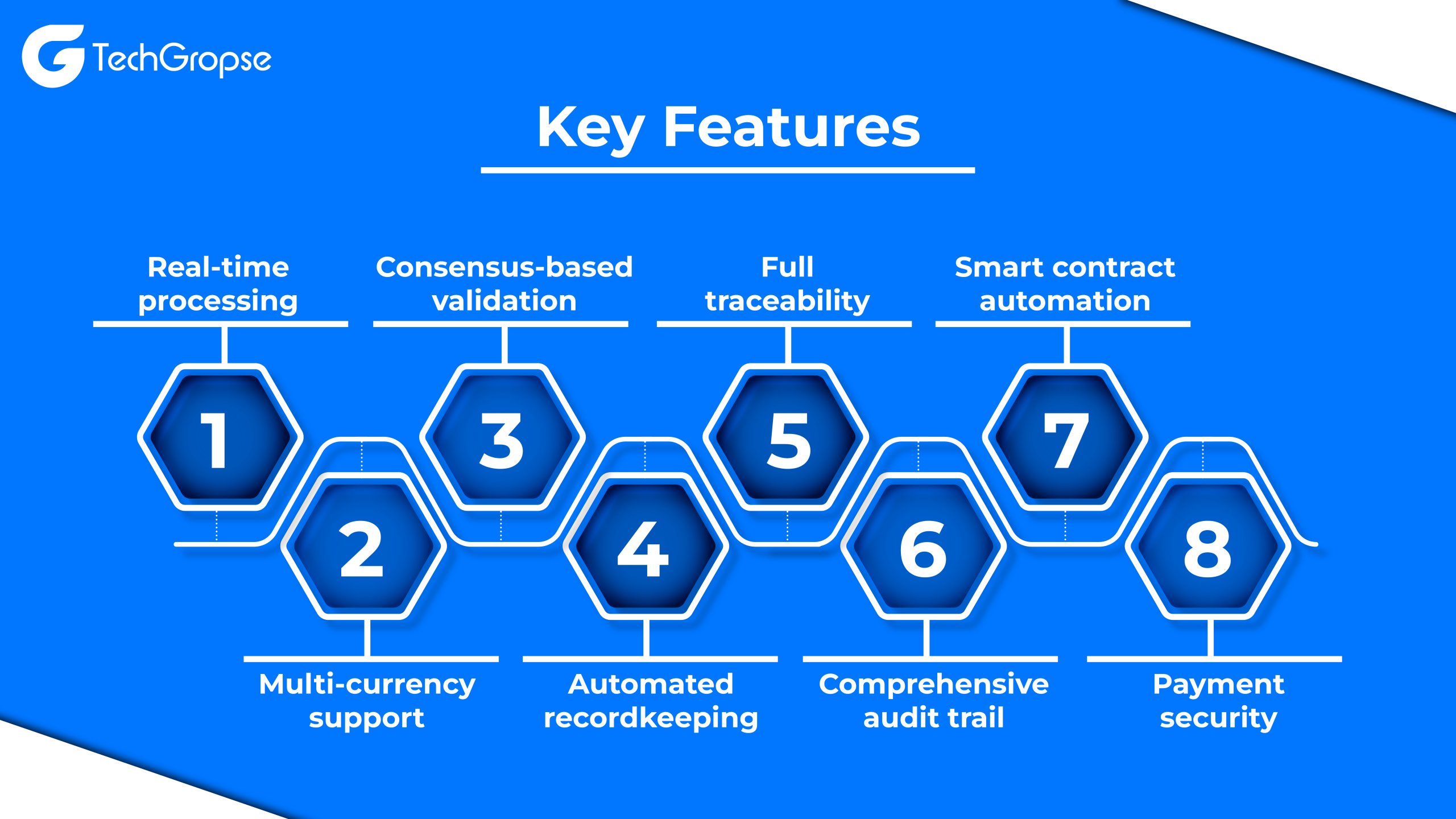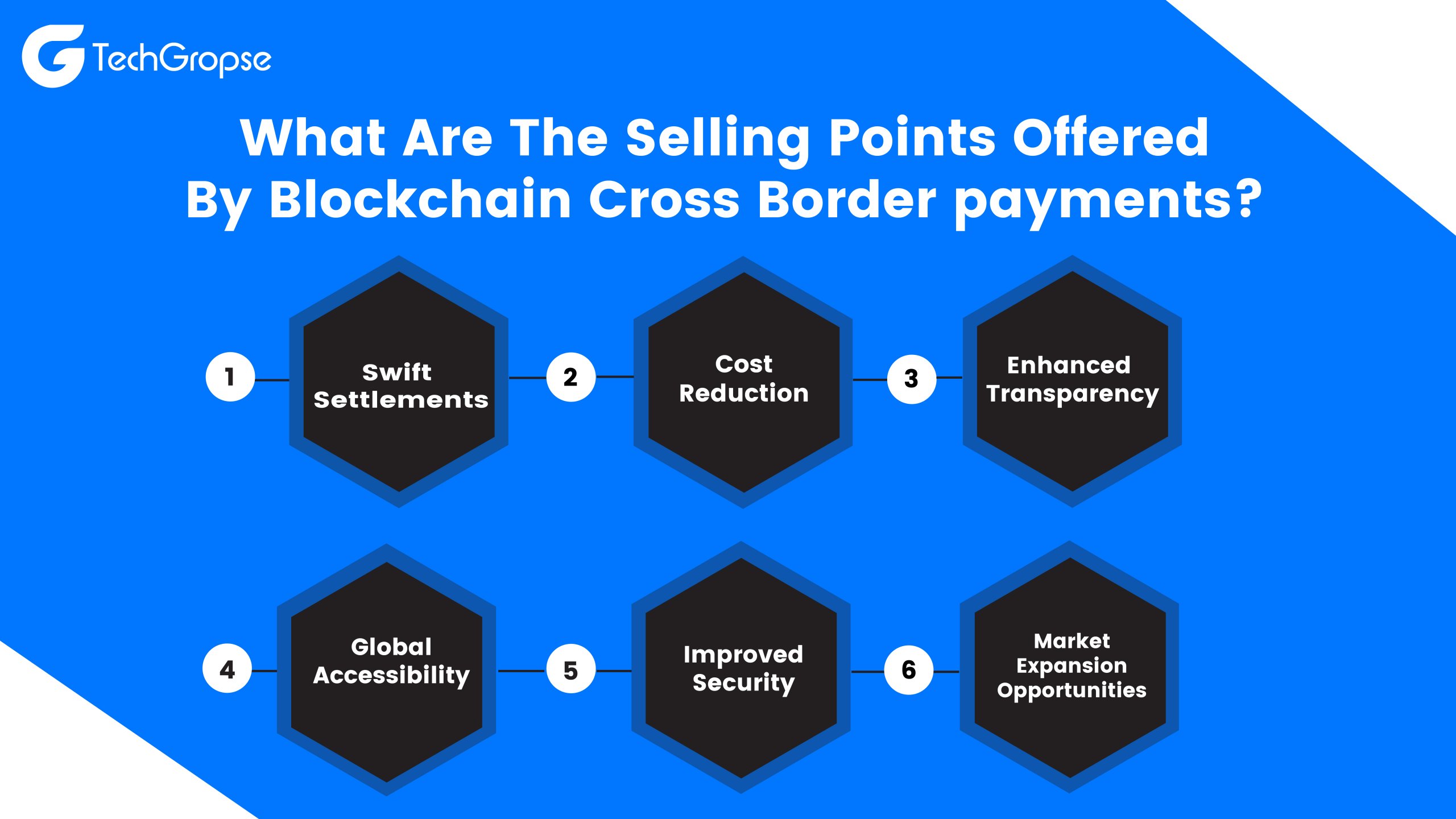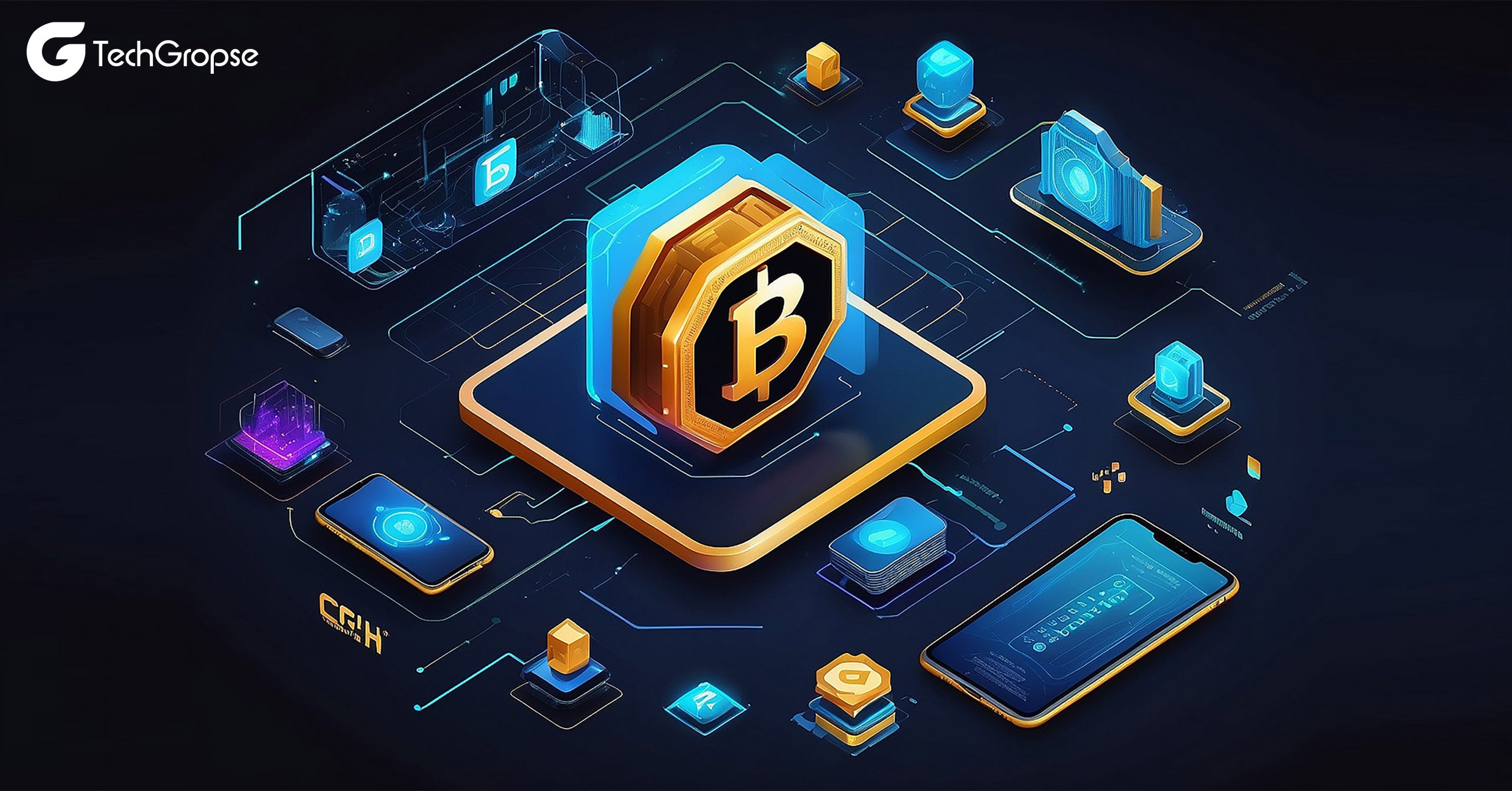What Are Blockchain Cross Border payments?
Cross Border Payments are the ones that take place between two parties living in two different countries through the blockchain technology. These settlements take place with ease and efficiency with the advancement of technology.
Blockchain for cross border payments takes only a second to process rather than hours or days. This helps in reduction of bounce rate of payment for about 40-80%, this allows secure payments giving you the permission to trace your payments and get payment related data with ease.
Information on Cross Border Payments Blockchain
Blockchain technology has been emerging as a solution in the tech field for a long time. We have observed the changes and advancements in cross border payments and settlements since the introduction of blockchain. In the year 2021, the blockchain sector represented about 15.9% of the $4.67 billion global blockchain market, according to the IDC Worldwide Blockchain Spending Guide. As the global blockchain market is projected to grow from $27.84 billion in 2024 to a staggering $825.93 billion by 2032, blockchain-based cross-border payments are expected to see significant expansion.
Juniper Research forecasts that blockchain-based B2B cross-border payments will make up 11% of total B2B international payments by 2024. The main appeal of the blockchain payment solutions is their capability to deliver fast, transparent, secure, and cost-effective payment processing across borders.
Why Should You opt for Cross Border Payments On blockchain?
– The transactions made through blockchain technology offer a significant reduction in the processing cost as compared to international banks. These start by eliminating intermediaries like commercial banks and clearing the houses. This efficiency is enhanced by cutting off times which results in faster processing of transactions.
– These independent e-payment systems like paypal or MoneyGram run on Blockchain ensuring that the security of these payments and sensitive data is kept from the risk of data breaches. In addition to this, these blockchain transactions are completely transparent, building a trust between the payers and payees along with people who provide cross border payment services.
The Architecture of Blockchain Cross Border Payments –
Blockchain-based cross-border payment solutions gives innovative architecture to surpass traditional methods.
At TechGropse, our approach involves network members or smart contracts initiating transactions, transmitted across a peer-to-peer (P2P) node network. Transactions are validated via consensus protocols, crucially enhancing security and reliability.
Permissioned blockchains are favoured by traditional financial institutions for high-value transfers, ensuring access only to trusted users. In contrast, permissionless blockchains cater to fintech and SMEs, promoting transparency and financial inclusion.
Validated data is securely encrypted and stored in immutable, timestamped blocks, forming a transparent ledger. Participants interact via customised web and mobile apps, maintaining synchronised copies of the ledger.
Integration with financial data markets, accounting software, and business-specific systems optimises payment initiation and analytics, enhancing operational efficiency and transparency in cross-border transactions.
Key Features –

At TechGropse, we have specialists of blockchain app development for cross-border payments that perfectly fits each client’s unique needs. Here are some key features of our solutions:
- Real-time processing:
Our blockchain ensures fast processing of cross-border payments 24/7 without intermediaries.
- Multi-currency support:
We support payments in any cryptocurrency, including popular ones, CBDCs (central bank digital currencies), and custom cryptocurrencies.
- Consensus-based validation:
Payments are validated based on predefined rules using our chosen consensus protocol.
- Automated recordkeeping:
After validation, payment transactions and related data are automatically timestamped and stored securely in an unchangeable ledger.
- Full traceability:
Our blockchain ledger allows real-time tracking and complete traceability of cross-border payments.
- Comprehensive audit trail:
We maintain a secure, immutable record of all payment-related documents, including invoices and receipts, throughout their lifecycle.
- Smart contract automation:
Smart contracts automate payment processes based on predefined conditions, such as releasing funds upon service delivery.
- Payment security: We ensure payment security through advanced measures like data hashing, digital signatures, multi-factor authentication (including biometrics), and fraud detection algorithms.
These features enable us to tailor our blockchain solutions to meet the specific and evolving needs of each client’s cross-border payment operations.
The Cost of Blockchain App Development

Based on the experience of TechGropse, developing blockchain software for cross-border payments typically ranges from $150,000 to $1,500,000.
Several key factors influence the cost and timeline:
- Functional Complexity: This includes the intricacy of smart contracts needed for automating cross-border payments.
- Integration Scope: The complexity of integrating with other systems such as banking platforms or financial data sources.
- Performance, Scalability, Security, and Interoperability: Requirements for robust performance, scalability to handle transaction volumes, security measures, and interoperability across different blockchain networks.
- Blockchain Network Type and Consensus Algorithm: Costs vary based on whether it’s a new blockchain network developed from scratch or leveraging an existing platform with chosen consensus protocols.
- User Experience (UX) and User Interface (UI): Tailoring web and mobile applications to meet specific user needs and compliance requirements.
Here are some estimated costs:
– $150,000–$250,000: Developing a cross-border payment app using an existing blockchain network.
– $500,000–$1,500,000: Creating a fully customized blockchain solution with a dedicated blockchain network for cross-border payments.
These estimates reflect the complexity and customization required to deliver secure, efficient, and compliant blockchain solutions for cross-border payment needs.
The Challenges of Blockchain for Cross Border Payments
Many business leaders remain uncertain about blockchain’s capability to handle operational and regulatory challenges in cross-border payments. With years of expertise in blockchain development, we confidently address these concerns efficiently and securely.
Challenge #1: Compliance with Anti-Money Laundering (AML) Regulations
A blockchain network for cross-border payments must adhere to global and regional AML/CFT regulations, including KYC, CDD, and FATF guidelines, to prevent illicit transactions and money laundering.
Solution:
Implement robust protocols within the blockchain network to ensure compliance with AML regulations, incorporating KYC verification and transaction monitoring to detect and prevent suspicious activities effectively.
Challenge #2: High Cryptocurrency Volatility
Blockchain solutions often use cryptocurrencies as a bridge between different fiat currencies (“fiat-crypto-fiat” model). However, significant price fluctuations in cryptocurrencies pose risks during currency conversion and transaction processing. The solution must mitigate these risks.
Solution:
Develop smart contracts that automate currency conversions based on real-time market rates, minimizing exposure to cryptocurrency volatility and ensuring stable transaction values.
Challenge #3: Continuous Data Integration from External Sources
Blockchain solutions for payments require seamless access to payment-related documents and current exchange rates for accurate transaction processing. Integration with external data sources is crucial for maintaining data integrity and operational efficiency.
Solution:
Enable real-time data feeds from trusted external sources into the blockchain network, ensuring up-to-date information on currency exchange rates and payment documentation. This integration enhances transparency and reliability in cross-border payment transactions.
Are Blockchain Cross Border Methods Better Than Traditional Payment Methods?
Distributed ledger technology is profoundly impacting industries, having a revolutionary transformation in global processes with its boundless potential. As advancements persist, consumers and businesses alike are discovering innovative ways to harness its capabilities across diverse applications.
The Functioning of Cross Border Payments Using Blockchain –
An instance of blockchain’s transformative power lies in its capacity to secure and streamline cross-border transactions. This advancement not only enhances operational efficiency but also elevates customer satisfaction, proving to be a pivotal asset for businesses striving to maintain a competitive edge in today’s landscape.
Cross-border payments using blockchain operate by having network members or smart contracts automatically execute transactions when predefined conditions are met. These transactions are then verified by a network of nodes using a consensus protocol.
Traditional banks, financial institutions, and large companies typically use permissioned blockchains for high-value transfers. These blockchains restrict access to trusted users with specific permissions to validate payment events. In contrast, fintech firms and small to medium enterprises (SMEs) prefer permissionless blockchains for smaller B2B and C2B transactions, as these promote inclusivity and offer maximum transparency.
Once validated, payment data is encrypted using a hash function and stored in timestamped blocks that are linked chronologically. This creates an unchangeable ledger, ensuring all payment activities can be tracked accurately.
Users interact with the blockchain through web and mobile applications tailored to their roles, allowing them to initiate, receive, and monitor payments. Each participant keeps an updated copy of the ledger, ensuring transparency and accountability throughout the payment process.
What Are the Selling Points Offered by Blockchain Cross Border payments?

The rapid advancement of technology, coupled with the growing influence of blockchain and cryptocurrency systems, has a quest for more efficient and cost-effective methods of conducting cross-border payments. These innovative technologies offer several compelling advantages:
- Swift Settlements:
By using blockchain network payment systems, cross-border transactions can now be executed with unprecedented speed, bypassing intermediaries such as banks or payment processors. This breakthrough ensures that payments are processed swiftly, typically within minutes instead of the conventional wait of several days. Moreover, blockchain facilitates direct fund transfers between senders and recipients, eliminating unnecessary middlemen and streamlining the payment process.
- Cost Reduction:
Traditional cross-border payments often incur substantial fees due to intermediary involvement and currency conversion costs. However, blockchain technology significantly reduces these expenses by eliminating intermediaries and their associated processing fees. This cost efficiency makes blockchain an attractive option for businesses and individuals seeking to minimise transaction costs.
- Enhanced Transparency:
Blockchain provides a transparent and immutable ledger of every transaction, enabling both senders and recipients to track the payment’s journey in real-time. This transparency plays a critical role in reducing the risk of fraud and instilling confidence in the payment system’s integrity.
- Global Accessibility:
The decentralised nature of blockchain technology enables it to operate independently of specific countries or jurisdictions. This characteristic makes blockchain an ideal solution for facilitating global payments, simplifying cross-border transactions without the complexities typically associated with foreign exchange.
- Improved Security:
Traditional payment systems often face security challenges due to their centralised nature and complex processes. In contrast, blockchain technology enhances security through its cryptographic protocols and decentralised consensus mechanisms. This robust security framework reduces the risk of unauthorised access and fraudulent activities, making blockchain-based payments more secure and reliable.
- Market Expansion Opportunities:
For businesses, blockchain technology opens new avenues for expansion into untapped markets that may have been previously inaccessible due to geographical distance or regulatory barriers. By offering a seamless and cost-effective payment solution, blockchain enables companies to reach new customer segments globally, fostering growth and market penetration.
Hire Blockchain App Developer from TechGropse

- Expertise in Blockchain Technologies:
Look for developers who have a deep understanding and practical experience with various blockchain platforms such as Ethereum, Hyperledger, or Corda. They should demonstrate proficiency in smart contract development, consensus algorithms, and decentralised application (dApp) architecture.
- Portfolio of Successful Projects:
Evaluate their portfolio to see if they have worked on projects similar to your requirements. A strong track record of delivering functional and secure blockchain applications indicates their competence and reliability.
- Knowledge of Security Best Practices:
Blockchain applications require robust security measures to protect sensitive data and transactions. Ensure the developer is well-versed in blockchain security best practices, including cryptographic algorithms and secure coding techniques.
- Integration Skills:
Check their ability to integrate blockchain solutions with existing systems or third-party services. Seamless integration is crucial for maximising the efficiency and functionality of your blockchain application.
- Problem-Solving Skills:
Look for developers who possess strong analytical and problem-solving skills. Blockchain development often involves overcoming complex technical challenges and optimising performance, so developers should demonstrate creativity and resilience in solving issues.
- Communication and Collaboration:
Effective communication is essential for successful project collaboration. Choose developers who can articulate technical concepts clearly, understand your project requirements thoroughly, and maintain open communication throughout the development process.
By focusing on these points, you can find a skilled blockchain app developer from TechGropse who not only meets your technical requirements but also aligns with your project goals and expectations.
Why Is TechGropse the Best Blockchain App Development Company?
Fintech App Development Solutions
TechGropse stands out as a premier blockchain app development company giving Fintech App Development Solutions for several compelling reasons. First and foremost, TechGropse boasts a team of highly skilled and experienced blockchain developers who are adept at leveraging cutting-edge technologies to create innovative and solutions. Whether it’s developing decentralised applications (dApps), implementing smart contracts, or integrating blockchain with existing systems, TechGropse excels in delivering tailored solutions that meet diverse client needs.
Their commitment to quality is reflected in their development processes, adherence to industry best practices, and continuous support post-deployment. This dedication ensures that clients receive not only a functional blockchain application but also a solution that enhances operational efficiency, reduces costs, and accelerates business growth.
To Conclude the Blog –
The sector of blockchain cross-border payments has seen remarkable growth within the blockchain payments industry. With its capacity for faster settlements, reduced costs, and enhanced security, blockchain technology has the potential to revolutionise how businesses process payments and transfer funds internationally.
Looking ahead, the future of blockchain in cross-border payments looks promising due to increasing acceptance among financial institutions and customers, ongoing developments in regulations and standards, and the emergence of innovative solutions that improve speed and scalability. As blockchain continues to evolve, it is positioned to transform the way businesses manage payments and streamline global operations effectively.
FAQs
1. How does blockchain technology improve cross-border financial transactions?
Blockchain technology enhances cross-border transactions by enabling direct peer-to-peer transfers without the need for intermediaries like banks. This speeds up transaction times significantly, often reducing them from days to minutes. Additionally, blockchain’s transparency ensures that transactions can be tracked in real-time, enhancing trust and reducing the risk of errors or fraud.
2. Are blockchain transactions secure for cross-border payments?
Yes, blockchain transactions are inherently secure due to their decentralised and cryptographic nature. Each transaction is encrypted and recorded across multiple nodes in the blockchain network, making it extremely difficult for malicious actors to alter transaction records. This level of security improves the integrity of cross-border payments and safeguards sensitive financial information.
3. What are the cost savings associated with using blockchain for cross-border payments?
Blockchain technology reduces costs by eliminating intermediaries such as banks and payment processors. These intermediaries typically charge fees for currency conversion, transaction processing, and administrative overhead. With blockchain, these costs are minimised, resulting in more cost-effective cross-border transactions for businesses and individuals alike.
4. Can blockchain technology handle regulatory requirements for cross-border transactions?
Yes, blockchain technology can comply with regulatory requirements by providing transparent and auditable transaction records. Participants in a blockchain network can verify transactions while maintaining privacy through encrypted data. Additionally, blockchain platforms can incorporate regulatory compliance features, such as Know Your Customer (KYC) protocols, to meet legal standards across different jurisdictions.
5. What are the challenges of implementing blockchain for cross-border financial transactions?
Implementing blockchain technology for cross-border transactions may face challenges such as scalability, interoperability with existing financial systems, and regulatory uncertainty. Scalability refers to the ability of blockchain networks to handle a high volume of transactions simultaneously.

Hello All,
Aman Mishra has years of experience in the IT industry. His passion for helping people in all aspects of mobile app development. Therefore, He write several blogs that help the readers to get the appropriate information about mobile app development trends, technology, and many other aspects.In addition to providing mobile app development services in USA, he also provides maintenance & support services for businesses of all sizes. He tried to solve all their readers’ queries and ensure that the given information would be helpful for them.











